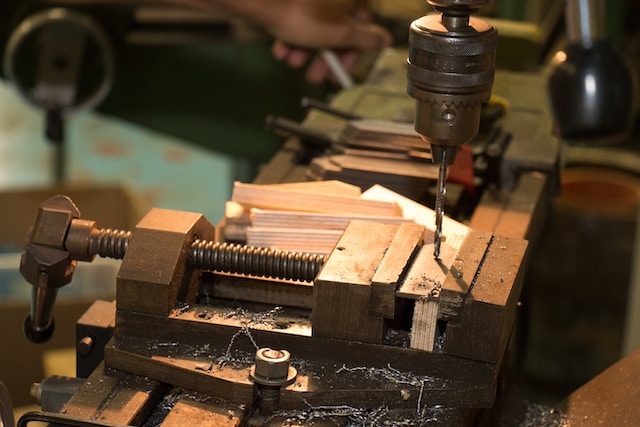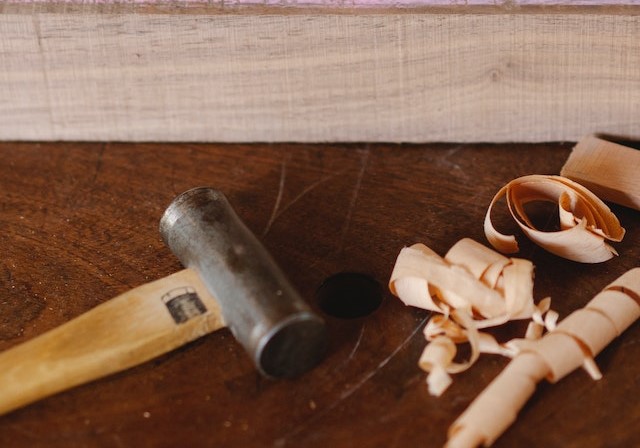How To Make A Perfect Tongue And Groove Joint For Your Woodworking Project

Are you looking to make a sturdy and seamless joint for your woodworking project? Look no further than the tongue and groove joint. This type of joint is commonly used in flooring, paneling, and cabinetry to create a tight fit and secure connection between boards.
In this article, we will guide you on how to make a perfect tongue and groove joint for your woodworking project, from selecting the right wood to the step-by-step process of cutting and fitting the pieces together.
With our tips and tricks, you’ll be able to create a seamless joint that will add both beauty and durability to your woodworking projects. Let’s get started!
Introduction to Tongue and Groove Joints
Hey there woodworkers and welcome to this guide on how to make the perfect tongue and groove joint for your next woodworking project! You may be wondering, what on earth is a tongue and groove joint? Well, let me introduce you to the most functional wood joint out there.
A tongue and groove joint is essentially a glorified interlocking or connecting mechanism used to create connections between two pieces of wood. This wood joint can also be used to make panels that have an overall consistent and seamless look. But what makes this greater than the sum its individual parts?
Well, tongue and groove joints come with some key benefits. For starters, they create a really strong bond so they’re the perfect solution when you want to secure two pieces together. Plus, when done right, they look great, making them the perfect option when aesthetic matters. What’s more – there aren’t too many tools required, making them a cost-effective choice for all your woodworking projects.
Oh, and I can’t forget to mention that there are several types of tongue and groove joints, each of which boasts unique benefits. These include biscuit joints, tongue and dado joints, T-joints and splined joints, just to name a few.
So now that you’ve got a better understanding of what a tongue and groove joint is, let’s talk about the tools you need to make the perfect one. Stay tuned for the next section.
What is a Tongue and Groove Joint?
Hey my woodworking friends, you know me. Today I’m here to talk to you about the Tongue & Groove joint. Let me tell you, it’s no easy feat to make a perfect-fitting joint – but you can do it!
So, what is a Tongue & Groove joint? Let me explain. It’s a type of joint where two pieces of wood are joined together. A tongue is cut on one piece of wood, and a groove is cut into the other piece. When these two pieces are put together, they fit together perfectly – like two pieces of a puzzle!
The key benefit of the tongue and groove joint is that it is a strong and tight joint that is perfect for a woodworking project. This type of joint is typically used to construct furniture, cabinets, walls, and floors. The joint allow for easy alignment, reducing the amount of time needed to construct your project and providing a clean, sturdy joint.
There are a variety of tongue and groove joint types to choose from. You can find a basic tongue and groove joint as well as miter joints, biscuit joints, rabbet joints, dado joints and more. Depending on your woodworking project, you may need to use a specific type of tongue and groove joint.
The tools you need to construct a tongue and groove joint can vary depending on the type of joint you are constructing. You will typically need some sort of saw, such as a miter saw, table saw, or circular saw, as well as a hammer, drill, and chisel. It is important to select the correct tools for the job in order to create a perfect fitting joint.
Now you know a bit about tongue and groove joints, let’s get into making one! For a perfect Tongue and Groove joint, it is important to take your time and be patient. Measure the dimensions of your wood carefully, cut the grooves and the tongue accurately, and make sure everything fits together perfectly before you commit to securing it with nails or glue.
Remember, when it comes to making the perfect tongue and groove joint for your project – choose the right wood and tools, take your time, and have patience. Doing a test fit of each piece before nailing or gluing can save you time further down the line and help you avoid costly mistakes.
Well, that’s all I have for you today my woodworking chums. Now you know a bit more about tongue and groove joints so why don’t you give it a go and see what you can create? You never know, you might be building furniture in no time!
Key Benefits of Tongue and Groove Joints

If you are considering starting a woodworking project, a great option is to use a tongue and groove joint. Not only will this method deliver a professional-looking finished product, but it also has several advantages that make it a great option for both amateur and professional woodworkers alike!
First, a tongue and groove joint provides a clean and flawless look with the wood coming from one continuous piece. This joint also gives your woodworking project strength and stability that other joinery methods don’t provide, making it a great option for any furniture or cabinetry project.
Not only does the tongue and groove joint create a sturdy base for your project, but it also helps keep the wood from warping or splitting. Since the tongue and groove work together as one piece, it provides better support throughout the wood and can keep it from splitting apart. This makes for a long-lasting project that can withstand wear and tear over time.
In addition, the tongue and groove joint is much easier to install than other jointing methods. With the right tools and some patience, it takes a fraction of the time compared to other joinery methods. This is great news for first-time woodworkers or anyone short on time but still wants to create amazing projects.
Finally, tongue and groove joints are also great for hiding imperfections in the wood. It’s always tricky to line up two pieces of wood exactly and even harder to match two different pieces of wood. The tongue and groove joint helps make this easier by hiding small variances in the wood.
Hopefully, you’re convinced that a tongue and groove joint is the way to go for your next woodworking project. It’s an ideal joint for hiding imperfections, creating a stronger overall project, and delivering a professional-looking result in a fraction of the time. It really is the perfect joint for any woodworking project!
Types of Tongue and Groove Joints
Ah, they teach ya this stuff in school, but they don’t get to a man’s real education on the types of tongue and groove joints you can put together!
When people talk about tongue and groove joints, they’re usually referring to the classic interlocking style of joint, where the edge of one piece of wood is shaped into alternating ridges and grooves, and the edge of the next piece of wood is shaped into the opposite – causing them to join together snugly. But there are so many more possibilities!
First of all, we have the cutting joint. It’s the simplest joint when it comes to tongue and groove and works with two parallel pieces of wood, such as two cabinets. A groove is made along the edges of one of the pieces, and a tongue is cut into the edge of the other. This allows them to join together perfectly, if made correctly.
Then there’s the blind join, which has some extra dimensions of complexity. It’s when two flat surfaces join – for example, the edges of two boards. This time, the groove is cut on the edge of one board and a tongue on the edge of the other, but no groove is cut on the opposite side. That means you’ll need to make sure they fit perfectly together so they don’t rub on each other.
Finally, there’s the classic tongue and groove joint. Basically, this is the joint most people imagine when they conjure up images in their minds of tongue and groove joints. It’s when two boards fit perfectly together and form a single, flat surface. It’s great for flooring and other projects and requires a bit of precision to get absolutely perfect.
So I hope this gives you a better idea of the sorts of tongue and groove joints out there; one-piece agains two-piece, cutting, blind and classic join. The secret is to measure twice, and only cut once, so your wood joins perfectly together for your woodworking projects. Good luck!
The Tools You Need for Perfect Tongue and Groove Joints
Oh, if you wanna make a perfect tongue and groove joint you’re gonna need some tools. Let me start by saying that woodworking isn’t like painting a portrait; you don’t just take a brush and some paint and go for it. For the truly perfect tongue and groove joint, there’s a few things you’ll need to get.
First order of business is nailing. You’re gonna need a hammer and nails, ideally some kind with a bigger head than your usual run of the mill nail. You’ll need the bigger head for stability, solidity and comfort. You’ll also want a saw to measure and cut the pieces you need. No project is gonna go perfect without a proper saw, unless you like making mistakes.
It doesn’t end there though, ain’t no woodworking project perfect without some drilling going on. Ya gotta make those holes somewhere, sure as shooting fits the bill. That said, you gotta get a drill and drill bit that’s the right size for the job. Otherwise, you might end up with a whole lotta mess in your hands, unless you like messes.
And you ain’t done yet! Don’t forget the chisel. Once you’re done doing the nail and saw thing, you gotta get that chisel working on that joint till it’s perfect and all nice. Probably gonna need a couple of chisels, depending on the project at hand. No matter what, you’re gonna need the right kind of chisel.
So that’s about it for the tools. Remember folks, no tools means no project and no tools means no perfect tongue and groove joint. Now, get out there and get to it!
Nailing
Ah, Nailing, what a classic tool for construction. Not just for constructing sheds, fences and decks, but also used to make the perfect tongue and groove joint. Nailing is an old-fashioned and simple way to secure the joint and make sure it stays together.
When nailing into wood, you need to make sure that the nails have the right size, length and shape. The most common are flat-headed nails and they always do the job. Make sure that they go deep enough into the wood, but not too deep. If they go too deep they won’t be able to provide enough grip. Another important thing to keep in mind is that the head of the nails should have a slightly larger diameter than the shaft. This way, you’ll avoid splitting the wood.
When nailing into the tongue and groove joint, make sure that the tongue side and groove side are the same size, so that the nails don’t sink in on one side and leave the other side exposed. A good trick is to insert some sort of temporary support on one side, like a spatula, while you nail into the other. This will keep the joint even.
When it comes down to choosing the right nails for a tongue and groove joint, you want to look for ones with a relatively narrow diameter. This will help ensure a tighter fit between the pieces. For extra security, you might also want to insert some wood glue before nailing.
The other thing you must keep in mind when nailing a tongue and groove joint is that you must keep the nails at an angle that is perpendicular to the surface of the wood. This will ensure a secure bond between the pieces. If you need to make any adjustments, you can use a hammer and use light taps to move the nails in the correct direction.
So, there you have it. Nailing is a simple, yet effective way to make a tongue and groove joint. With the right tools, skills and patience, you can make sure that your joint will look perfect. So the next time you’re starting a woodworking project, consider nailing for your tongue and groove joint. You won’t regret it.
Sawing
Sawing is an essential part of making the perfect tongue and groove joint. Many electric saws are available, but depending on your budget, needs, and preferences, you might also consider manual saws.
When sawing, remember to wear protective gear, such as eye and ear protection, a face mask and gloves. Depending on the type of saw andcut you’re making, you’ll also want safety goggles. To keep your fingers safe, always keep your hand away from the blade!
To use a saw, first mark the line you’ll be cutting. Clamp the wood in place and make sure it’s secure. Start sawing on the mark, following it in a smooth and steady manner. Allow the saw to do the work. Don’t force it to cut.
Saws generally come with cobalt, steel or hardened blades. Different saws have different tooth configurations and may be better for different types of wood.For example, circular saws (with varying blade sizes) are best for making straight cuts, whereas crosscut saws (with 8 or more teeth per inch) are better for cutting at an angle.
Once your cut is complete, take a few moments to check it for accuracy. If you see any irregularities, take your time to fine-tune the edge.
One of the main keys to successful sawing is proper maintenance of your saw blades. Dull blades have a greater chance of splintering and ripping the wood, so make sure to sharpen them often. Keep the blades clean and make sure that any damage is repaired or replaced.
Sawing can seem intimidating at first, but if you follow these basic steps, you’ll be making perfect tongue and groove joints in no time. Just remember to take your time and be patient – and keep your hands away from the blade!
Hammering

Ah, hammering. This is the fun part of making a tongue and groove joint! Hammering is a crucial step in the process, so make sure you pay close attention to the details.
You’ll want to start off by measuring out your wood and cutting the grooves and tongues. Once you have the tongue and groove cut, you need to make sure the pieces fit together correctly. You can use a hammer to gently tap the pieces together until they fit.
Next, you’ll want to choose the nails that you’re going to use. Make sure they’re the right size and length for your project. Then place your nails inside the groove and use your hammer to drive them into the wood. You want to make sure you don’t over-drive the nails, as this could cause damage to the wood.
Once you’ve secured the pieces with nails, use a hand saw to cut off any excess nail lengths that are sticking out of the joint. Finally, use a chisel to refine the joint and give it a nice, smooth finish.
Hammering is a great skill to have in your woodworking toolbox. With a steady hand and the right tools, you can make sure that your tongue and groove joint comes out looking amazing. So go on, grab your hammer and nails and get to pounding!
Drilling
Drilling is an important part of the process of making a perfect tongue and groove joint. It is important to have the right tools and be prepared before starting this step in the process.
Let me start by saying that, if you don’t have a drill – don’t worry. I had a lot of trouble fitting the tongue and groove pieces together without a drill. I was going to run to the store to get one but I realized that I had a very old and outdated cordless drill covered in dust. After a lot of effort and scraping, I finally managed to get it to work again and it did the trick! I was happy; I would’ve wasted a lot of time and money if I had to buy a new drill.
Now, if you already have a drill then great; now you have to decide on the type of bit you need. I recommend using a plunge router bit or a construction tool with a tongue and groove-cut bit. These are great for creating accurate and cleaner cuts in wood. Plus you’ll be able to work faster, because you don’t have to measure and mark with a pencil as often as with a handsaw.
Once you’re all set, you can start drilling. Make sure you measure the thickness of your wood pieces and the length of the tongue and groove before drilling. This will help make sure you are drilling in the right place. Start by drilling with a steady, slow speed and don’t press down too hard. After you’ve drilled all the way through, it’s important to check the drill is finished cutting cleanly on each side.
Finally, remember that drilling can be a time-consuming and messy process, but it’s worth it in the end. With a little patience and the right equipment, you can make a perfect tongue and groove joint every time!
Chiseling

If you’re a woodworker, chiseling can take your tongue and groove joint to the next level for sure. If you thought it was hard to picture me telling jokes about chiseling, you got another thing comin’. Pull up a chair, grab a cold one and listen up!
Chiseling involves cutting or trimming away portions of a grooved surface, which is exactly what our tongue and groove joint requires. All kidding aside, it is a little more technical than that, so give me your best poker face.
You’ll want to make sure when chiseling that you set up your chisel perpendicular to the wood, not diagonally. That’s a lesson even I learned the hard way. Also, use an angled chisel ( which looks a lot like an ice cream scoop) to make sure the cross-section of the tongue and groove joint is an even 90 degrees.
But wait, that’s not all on chiseling. You should also make sure you trim off any uneven areas carefully, without accidentally gouging any other part of the groove. As much as the bloopers will get the biggest laughs, trust me, you don’t want any bloopers when making a tongue and groove joint.
Now that you know a little more about chiseling, it’s time to get out your chisel and cut some wood. Ahh, that’s music to our ears, isn’t it? Just make sure to chisel away in the same direction and in a straight line.
Now that you know the basics of chiseling, get to it and start making that perfect tongue and groove joint for your woodworking project. After all, it’s worth it for the sweet satisfaction of hearing yourself say, “I did it myself!.
Step by Step Guide to Making the Perfect Tongue and Groove Joint
Look, I’m no carpenter, but everyone knows that when you’ve got a woodworking project, there’s no doing it right unless you get that tongue and groove joint perfect. So, if you ever find yourself trying to make a shelf or a bed frame, or maybe even a few new pieces of furniture, then this guide is here to help ya out!
The first thing you’ve gotta do is measure the dimensions of the wood you’re working with. Just use a ruler or a measuring tape to get a proper length and width of each piece. Now that you know the size of the wood, you can start cutting your grooves! Grab a circular saw and start making some cuts in the wood–this will create the groove you need for the tongue to fit in. It’ll take a few passes to get through, so be patient and keep cutting until it’s just right.
Once you’ve cut the groove, it’s time to move over to the tongue. Grab a jigsaw and start cutting the tongue out–the shape should be the exact same as the groove you just cut, but with a bit of extra wood added in to give it the ‘tongue’ part. Once you’ve got that all ready, it’s time to test fit it in the groove. It may take a few tries to get it just right, but that’s ok! An important part of this job is making sure the pieces fit perfectly.
When you feel like you’ve got the pieces fitting just right, it’s time to get to sealing it. You can either nail it together or use some glue, but either way the goal is to make sure the pieces are secure. Once you’ve done that, grab a sander and some sandpaper and start sanding down the edges of the joint until it’s smooth and refined.
And there you have it! With a few simple steps, you’re ready to have yourself a perfect tongue and groove joint for your woodworking project. I bet you never expected to be this good at carpentry, eh? Congratulations!
Tips and Tricks for Making the Perfect Tongue and Groove Joint

Ahh, we’ve got some tips and tricks for making the perfect tongue and groove joint. After all, who doesn’t want a joint that doesn’t make you look like an amateur woodworker? Let’s get through these quickly and get you on your way to the perfect joint.
First, you’ll want to make sure you choose the right wood and tools. Go for the highest quality material and invest in quality tools; this will help make this project much easier to do. We know it feels tempting to skip out on the good tools and settle for the cheapest option. But trust us, it will make a huge difference in the long run.
Second, let’s talk about taking your time and being patient. It’s so important to take your time and be patient when it comes to making the perfect joint. Making sure each step is done correctly and that all of the pieces fit together perfectly takes time and planning. Don’t rush it, be patient and enjoy the process.
Last but not least, you should always test fit each piece before nailing or gluing. Testing that each piece fits together correctly before nailing or gluing it will give you much better results and prevent any gaps or misalignment. You’ll be happy you did it when you have the perfect joint that looks like it was made by a professional.
And there you have it, your tips and tricks for making the perfect tongue and groove joint. Don’t forget to invest in the right materials and tools, take your time and be patient, and test fit each piece before nailing or gluing. With these simple tips you’ll be on your way to the perfect joint in no time.






